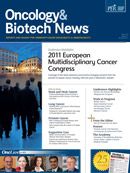Personalized Medicine Offers Great Hope, Great Challenges
Cancer treatment is moving from a one-size-fits-all approach to personalized medicine, which means matching the right drug with the right tumor characteristics.

Gordon B. Mills, MD, PhD
Cancer treatment is moving from a one-size-fits-all approach to personalized medicine, which means matching the right drug with the right tumor characteristics. Although personalized medicine has seen some exciting advancements in identifying tumor targets through genomic sequencing and developing treatments aimed at those targets, other successes, such as trastuzumab for HER2-positive breast cancer and imatinib for chronic myelogenous leukemia and gastrointestinal stromal tumor (GIST), do not tell the whole story. The Holy Grail may be in sight, but it remains elusive.
“While there is incredible excitement about the potential implementation of personalized cancer therapy, it is easy to contend that the excitement is massively overblown by the press,” said Gordon B. Mills, MD, PhD, of the University of Texas MD Anderson Cancer Center in Houston, at the European Multidisciplinary Cancer Congress in Stockholm, Sweden.
“The number of successes—and in most cases these are only found in small subpopulations of patients and are transient—are outnumbered by spectacular failures,” he continued. “The cost of targeted therapy has added a tremendous burden to healthcare for a minor improvement in outcomes in small subpopulations. We are far from overcoming the hurdles associated with the implementation of personalized cancer therapy.”
Mills added, “We are coming closer to having scientific underpinnings for personalized medicine, but integrating our discoveries is an art. We have to ask ourselves whether we are overpromising successful treatments for cancer. Is this hype? Is this fundraising? Will there be repercussions if we don’t deliver on our promises?”
For trials of personalized medicine, each patient represents an “n” of 1. The therapy has to work with the specific patient’s genomics. Just identifying mutations does not mean that they are actionable and druggable; even if a tumor has actionable mutations, many responses to targeted therapy are in small subpopulations of patients and are short-lived. Also, regulatory hurdles need to be overcome for approval of targeted therapies.
In lieu of an ability to treat individual patients based on the changes in the genomes, experts are moving toward stratified therapy and treating groups of patients with similarities in their tumors, but Mills acknowledged that this is fraught with challenges. “Breast cancer is leading the way [in tumor stratification],” he said. “Ductal carcinoma used to be considered one disease; now eight subclasses have been identified. Some of these subgroups are orphan diseases and too small for clinical trials.”
Only subpopulations of patients with a particular biomarker show a response to targeted therapy, and the response is typically not durable. “We need to convert these short-lived responses to durable ones,” he said. He gave the example of the targeted agent crizotinib, which achieved a remarkable response in a subpopulation of lung cancer patients with the ALK mutation, “but every patient has recurred.”
“
We are coming closer to having scientific underpinnings for personalized medicine, but integrating our discoveries is an art. We have to ask ourselves whether we are overpromising successful treatments for cancer. Is this hype? Is this fundraising? Will there be repercussions if we don’t deliver on our promises? ”
—Gordon B. Mills, MD, PhD
Challenges in Personalized Medicine
The success of any cancer therapy is partly determined by the patient’s nongenetic makeup, the tumor characteristics, and the drug’s therapeutic index and toxicity. Tumor heterogeneity represents a challenge because characteristics of the primary tumor often change at relapse and at metastasis, signaling the need for rebiopsy at stages of disease progression. In some cases, the primary tumor itself may be heterogeneous at different sites. Therapy should be sequenced based on the shift in characteristics at disease progression, Mills told the attendees.
With improved ability to characterize tumors in greater depth, multiple mutations are being identified, posing another hurdle to targeted therapy. When a mutational target is identified and targeted treatment is initiated, compensatory pathways may be activated, causing the emergence of resistance.
One focus of research is to distinguish between “passenger” mutations and “driver” mutations. “Not all mutations are targetable,” said Mills.
The price of mutational testing is considerable. There is the cost of genomic sequencing, and then the costs of handling and storing data, which can be much more expensive than genomic sequencing itself. Targeted therapies themselves are also quite expensive, and, as mentioned, responses are typically not durable. Further, genomic testing is not 100% accurate, Mills said. Only 70% of tests are true positive and 70% are true negative. “The best deep-sequencing technologies come with increased cost,” he said.
Ethical considerations also come into play. Patients may not want to know their germ-line aberrations. Regulatory issues are another challenge. Validated assays for tumor testing are not available, and genomic testing is not reimbursed by about 95% of carriers. “We need to make genomic testing billable and payable,” stated Mills.
Also, physicians and patients need to be educated about genomic testing. “Most physicians at MD Anderson don’t understand what all the sequencing tests mean,” he said.
There are many unknowns, including whether a mutation present in only 1 tumor cell has any significance. “Patients hear about ‘cures’ and ‘nontoxic therapy,’ and we need to be more realistic about what we present to patients,” said Mills.
“
The cost of targeted therapy has added a tremendous burden to healthcare for a minor improvement in outcomes in small subpopulations. We are far from overcoming the hurdles associated with the implementation of personalized cancer therapy. ”
—Gordon B. Mills, MD, PhD
Pilot Program at MD Anderson
MD Anderson Cancer Center has launched a personalized medicine pilot program that services about 30,000 patients per year. The goal is to identify targetable and druggable genetic aberrations versus no aberrations. “Then we go to ‘n’ of 1 clinical trials to determine if a patient will benefit from a targeted therapy,” said Mills.
In the pilot program, 996 patients underwent testing with a mass array of 44 genes to identify activating mutations. There are 457 cancer-associated genes; 122 of them occur at a significant frequency in epithelial tumors. Less than 25% of mutations identified were actionable, and most of them were quite rare.
“We were surprised and disappointed. P53 was the most common aberration, but there is no targeted treatment for this,” said Mills. “Fifteen percent were Ras mutations, which are markers of resistance. The percentage with actionable mutations was much lower than in the literature.”
“The patient’s underlying gene lineage is important to response,” Mills said. “You can have efficacy with a targeted therapy, but it is determined by the patient’s lineage and tumor cell aberration.”
Patients with low-grade disease and mutations are frequently cured by targeted therapy, but most patients with advanced disease tend to have p53 mutations. “So we promise all patients that we can treat them, but only a few have actionable mutations,” said Mills. The ultimate outcome of a given cancer is determined by metastatic lesions that may differ from the primary tumor, he added.
Breast cancer is “the poster child for stratified medicine.” In the pilot program, Mills and colleagues looked at 51 primary breast tumors and 56 metastases. Over 40% of the time, the dominant clone was discordant.
“Patients with concordance of PTEN, estrogen receptors, progesterone receptors, and HER2 have a better outcome, while the outcome is dismal for those who are discordant,” said Mills. “Potentially, we have to obtain multiple biopsies to know what we are treating. In one study, the primary tumor had heterogeneity at different sites.”
Testing for genetic aberrations does not always yield results that can be acted upon. “In 10 patients where we’ve sequenced the majority of the genome, not one new actionable mutation was found,” said Mills. “Most mutations we find are not drivers.” For example, out of the 16 mutations most common in acute myelogenous leukemia and the 237 most common mutations in lung cancer, less than 6 were targetable.
“Many mutations are only passengers, not drivers,” he emphasized. “The ‘noise’ in mutations is challenging.”
A new program has been initiated at MD Anderson to distinguish between passenger and driver mutations. Thus far, investigators have identified a set of PK13R1 driver mutations.
“The future of personalized medicine will entail biopsy, biopsy, biopsy,” said Mills. “Eventually we hope to be able to move from biopsy to imaging and use of blood and circulating tumor cells to identify mutations.”
Mills envisions the process as follows: characterize the primary tumor and metastases, identify subclones, move to a trial of therapy (“n” of 1), and then biopsy at recurrence. “Personalized medicine offers great hope and many challenges. It is indeed a team science,” he said.




